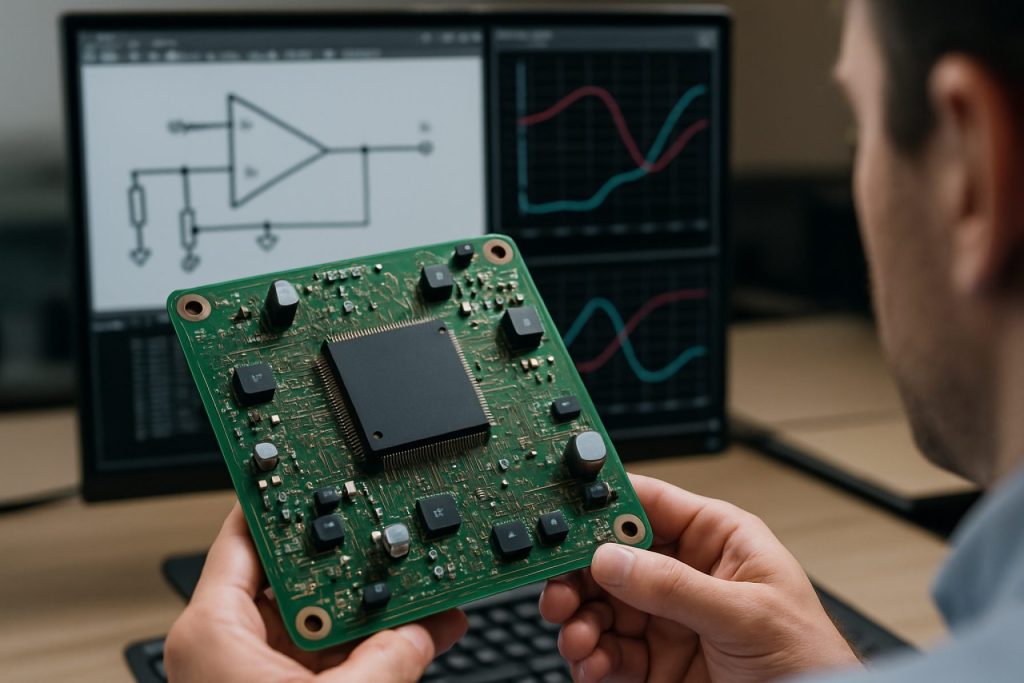
2025 Mixed-Signal IC Design Automation Market Report: Unveiling Growth Drivers, AI Integration, and Global Opportunities for the Next 5 Years
- Executive Summary & Market Overview
- Key Technology Trends in Mixed-Signal IC Design Automation
- Competitive Landscape and Leading Vendors
- Market Growth Forecasts (2025–2030): CAGR, Revenue, and Volume Analysis
- Regional Market Analysis: North America, Europe, Asia-Pacific, and Rest of World
- Challenges, Risks, and Emerging Opportunities
- Future Outlook: Innovation Pathways and Strategic Recommendations
- Sources & References
Executive Summary & Market Overview
Mixed-signal IC design automation refers to the suite of electronic design automation (EDA) tools and methodologies that enable the efficient design, simulation, verification, and layout of integrated circuits (ICs) containing both analog and digital components. As of 2025, the market for mixed-signal IC design automation is experiencing robust growth, driven by the proliferation of smart devices, automotive electronics, IoT applications, and the increasing integration of analog and digital functionalities on a single chip.
Mixed-signal ICs are critical in bridging the gap between the analog real world and digital processing, making them indispensable in applications such as wireless communications, sensor interfaces, power management, and automotive safety systems. The complexity of these designs, which require precise coordination between analog and digital domains, has fueled demand for advanced automation tools that can streamline design cycles, reduce errors, and improve time-to-market.
According to Synopsys and Cadence Design Systems, two leading EDA vendors, the adoption of mixed-signal design automation tools is accelerating as semiconductor companies seek to address challenges such as shrinking process nodes, increased design complexity, and the need for higher performance with lower power consumption. The integration of machine learning and AI-driven verification within EDA platforms is further enhancing productivity and design accuracy.
Market research from Gartner and MarketsandMarkets projects that the global EDA market, with mixed-signal automation as a significant segment, will continue to expand at a compound annual growth rate (CAGR) exceeding 7% through 2025. This growth is underpinned by the rapid evolution of end-user industries such as automotive (notably ADAS and EVs), consumer electronics, and industrial automation, all of which demand sophisticated mixed-signal ICs.
- Key market drivers include the rise of 5G, edge computing, and AI-enabled devices, all of which require advanced mixed-signal integration.
- Challenges persist in the form of analog-digital co-simulation, verification bottlenecks, and the shortage of skilled mixed-signal designers.
- Leading EDA vendors are investing in cloud-based design environments and collaborative platforms to address these challenges and support geographically distributed design teams.
In summary, the mixed-signal IC design automation market in 2025 is characterized by strong demand, technological innovation, and a critical role in enabling next-generation electronic systems across multiple industries.
Key Technology Trends in Mixed-Signal IC Design Automation
Mixed-signal IC design automation is undergoing rapid transformation as the demand for integrated analog and digital functionalities in a single chip accelerates across sectors such as automotive, IoT, and communications. In 2025, several key technology trends are shaping the landscape of mixed-signal IC design automation, driven by the need for higher performance, lower power consumption, and faster time-to-market.
- AI-Driven Design Automation: Artificial intelligence and machine learning algorithms are increasingly being integrated into electronic design automation (EDA) tools to optimize mixed-signal design flows. These AI-powered tools can predict design bottlenecks, automate analog layout generation, and enhance verification processes, significantly reducing manual intervention and design cycle times. Companies like Cadence Design Systems and Synopsys are at the forefront, embedding AI capabilities into their mixed-signal design suites.
- Advanced Co-Simulation and Co-Verification: The complexity of mixed-signal systems necessitates robust co-simulation environments that can accurately model interactions between analog and digital domains. Enhanced co-simulation tools now offer tighter integration, higher simulation speeds, and improved accuracy, enabling designers to identify and resolve issues earlier in the design process. Siemens EDA (formerly Mentor Graphics) has introduced advanced mixed-signal verification platforms that streamline this process.
- Process Technology Scaling and PDK Enhancements: As process nodes shrink to 5nm and below, foundries are providing more sophisticated process design kits (PDKs) tailored for mixed-signal applications. These PDKs include detailed models for analog behavior, parasitics, and reliability, enabling more accurate design and faster signoff. TSMC and Samsung Foundry are leading in offering advanced mixed-signal PDKs for next-generation nodes.
- Cloud-Based Design Platforms: The adoption of cloud-based EDA platforms is accelerating, offering scalable compute resources and collaborative environments for geographically dispersed design teams. This trend is particularly beneficial for mixed-signal projects, which often require extensive simulation and verification. Ansys and Cadence Design Systems have expanded their cloud offerings to support mixed-signal workflows.
These trends are collectively enabling faster, more reliable, and cost-effective development of mixed-signal ICs, positioning the industry to meet the evolving demands of 2025 and beyond.
Competitive Landscape and Leading Vendors
The competitive landscape of the mixed-signal IC design automation market in 2025 is characterized by a concentrated group of established electronic design automation (EDA) vendors, alongside a growing cohort of specialized startups. The market is driven by the increasing complexity of mixed-signal system-on-chip (SoC) designs, the proliferation of IoT and automotive electronics, and the demand for advanced verification and simulation tools.
Leading the market are global EDA giants such as Cadence Design Systems, Synopsys, and Mentor, a Siemens Business. These companies offer comprehensive mixed-signal design suites that integrate analog, digital, and RF design flows, enabling seamless co-simulation and verification. For instance, Cadence’s Virtuoso platform and Synopsys’ Custom Compiler are widely adopted for their robust mixed-signal capabilities and integration with digital design environments.
In 2025, Cadence Design Systems continues to hold a leading position, leveraging its Virtuoso ADE and Spectre simulation technologies, which are considered industry standards for analog and mixed-signal design. Synopsys maintains a strong presence with its Custom Design Family, focusing on productivity improvements and AI-driven automation. Mentor (Siemens EDA) differentiates itself with its Analog FastSPICE platform and advanced verification solutions, targeting automotive and industrial applications.
Emerging players and niche vendors are also making inroads, particularly in specialized domains such as low-power IoT, RF, and high-speed data converters. Companies like Ansys (with its RaptorX and Totem tools) and Empower Semiconductor are gaining traction by offering targeted solutions for power integrity and mixed-signal verification. Additionally, startups such as Analog EDA are innovating with cloud-native and AI-augmented design tools, aiming to reduce time-to-market for complex mixed-signal ICs.
- Market consolidation is ongoing, with major players acquiring niche tool providers to expand their mixed-signal portfolios.
- Strategic partnerships between EDA vendors and foundries (e.g., TSMC, GlobalFoundries) are intensifying, ensuring tool compatibility with advanced process nodes.
- Open-source initiatives and interoperability standards are gaining momentum, but proprietary platforms still dominate mission-critical workflows.
Overall, the 2025 mixed-signal IC design automation market is defined by technological innovation, ecosystem integration, and a competitive push toward greater automation and design productivity.
Market Growth Forecasts (2025–2030): CAGR, Revenue, and Volume Analysis
The mixed-signal IC design automation market is poised for robust growth between 2025 and 2030, driven by escalating demand for integrated circuits that combine analog and digital functionalities in sectors such as automotive, consumer electronics, and industrial automation. According to projections by Gartner and corroborated by MarketsandMarkets, the global mixed-signal IC design automation market is expected to register a compound annual growth rate (CAGR) of approximately 8.5% during the forecast period.
Revenue forecasts indicate that the market, valued at around USD 1.7 billion in 2024, will surpass USD 2.9 billion by 2030. This growth is underpinned by the proliferation of advanced driver-assistance systems (ADAS), IoT devices, and 5G infrastructure, all of which require sophisticated mixed-signal ICs and, consequently, advanced design automation tools. The increasing complexity of system-on-chip (SoC) designs is also compelling semiconductor companies to invest in more capable electronic design automation (EDA) solutions, further fueling market expansion.
In terms of volume, the number of mixed-signal IC design projects is projected to grow at a CAGR of 7–9% through 2030, as reported by SEMI. This uptick is attributed to the rising adoption of automation in design workflows, which accelerates time-to-market and reduces design errors, making it feasible for companies to undertake more projects simultaneously.
- Regional Insights: Asia-Pacific is expected to maintain its dominance, accounting for over 45% of global market revenue by 2030, driven by the presence of major foundries and a burgeoning electronics manufacturing ecosystem (IC Insights).
- End-User Segments: Automotive and industrial sectors are forecasted to exhibit the highest adoption rates, with CAGR exceeding 9% in these verticals, as per IDC.
Overall, the mixed-signal IC design automation market is set for sustained expansion through 2030, propelled by technological advancements, increasing design complexity, and the relentless push for innovation in semiconductor applications.
Regional Market Analysis: North America, Europe, Asia-Pacific, and Rest of World
The global market for mixed-signal IC (integrated circuit) design automation is experiencing robust growth, with regional dynamics shaped by technological innovation, semiconductor industry investments, and end-user demand. In 2025, North America, Europe, Asia-Pacific, and the Rest of the World (RoW) each present distinct opportunities and challenges for vendors and stakeholders in this sector.
- North America: North America remains a leading region, driven by the presence of major EDA (Electronic Design Automation) vendors and a strong ecosystem of semiconductor design houses. The United States, in particular, benefits from significant R&D investments and a concentration of fabless companies and foundries. The region’s focus on advanced automotive, IoT, and 5G applications is fueling demand for sophisticated mixed-signal IC design tools. According to SEMI, North American semiconductor equipment billings reached record highs in 2024, underscoring the region’s continued leadership in design and manufacturing.
- Europe: Europe’s mixed-signal IC design automation market is characterized by strong automotive and industrial electronics sectors. Countries like Germany, France, and the Netherlands are investing in R&D for automotive electrification, industrial automation, and smart infrastructure, all of which require advanced mixed-signal ICs. The European Union’s “Chips Act” is expected to further stimulate local design and manufacturing capabilities, as noted by European Commission. Collaboration between EDA vendors and research institutes is fostering innovation in low-power and high-reliability mixed-signal design.
- Asia-Pacific: Asia-Pacific is the fastest-growing region, propelled by the dominance of countries such as China, Taiwan, South Korea, and Japan in semiconductor manufacturing. The region’s rapid adoption of consumer electronics, 5G infrastructure, and automotive electronics is driving demand for advanced mixed-signal IC design automation tools. According to SEMI, Asia-Pacific accounted for over 60% of global semiconductor equipment sales in 2024, reflecting its central role in the global supply chain. Local governments are also investing heavily in EDA tool development to reduce reliance on foreign technology.
- Rest of World (RoW): While smaller in market share, regions such as Latin America and the Middle East are gradually increasing their presence in the mixed-signal IC design automation market. Growth is primarily driven by investments in telecommunications infrastructure and emerging electronics manufacturing hubs. Initiatives to develop local talent and foster partnerships with global EDA vendors are expected to support gradual market expansion in these regions, as highlighted by Gartner.
Overall, regional market dynamics in 2025 are shaped by a combination of technological leadership, government policy, and end-market demand, with Asia-Pacific and North America leading in both innovation and adoption of mixed-signal IC design automation solutions.
Challenges, Risks, and Emerging Opportunities
The landscape of mixed-signal IC design automation in 2025 is characterized by a complex interplay of challenges, risks, and emerging opportunities. As the demand for highly integrated systems-on-chip (SoCs) grows—driven by applications in automotive, IoT, 5G, and AI—designers face mounting pressure to deliver robust mixed-signal solutions with shorter time-to-market and higher performance.
One of the primary challenges is the inherent complexity of mixed-signal design, which requires seamless integration of analog and digital components. Traditional EDA tools often struggle to provide accurate co-simulation and verification environments, leading to increased risk of design errors and costly silicon respins. The lack of standardized design flows and interoperability between analog and digital toolchains further exacerbates these issues, as highlighted by Synopsys and Cadence Design Systems in their recent technical whitepapers.
Another significant risk is the growing impact of process variability at advanced nodes (e.g., 5nm and below). As device geometries shrink, analog performance becomes more sensitive to manufacturing variations, making accurate modeling and yield prediction increasingly difficult. This challenge is compounded by the limited availability of skilled analog designers, which can bottleneck project timelines and increase the risk of design flaws, as noted by SEMI in its 2024 industry outlook.
Despite these hurdles, several emerging opportunities are reshaping the market. The adoption of machine learning and AI-driven design automation is enabling faster and more accurate analog layout generation, verification, and optimization. Companies like Ansys and Mentor, a Siemens Business are investing heavily in AI-powered EDA solutions that promise to reduce design cycles and improve first-pass success rates. Additionally, the rise of open-source EDA initiatives and cloud-based design platforms is lowering entry barriers for startups and smaller design houses, fostering innovation and competition.
- Challenge: Integration complexity and lack of standardized mixed-signal design flows.
- Risk: Increased process variability and analog sensitivity at advanced nodes.
- Opportunity: AI-driven automation and cloud-based EDA tools accelerating design and verification.
In summary, while mixed-signal IC design automation in 2025 faces significant technical and resource-related challenges, the rapid evolution of AI-enabled tools and collaborative platforms is opening new avenues for efficiency and innovation in the sector.
Future Outlook: Innovation Pathways and Strategic Recommendations
The future of mixed-signal IC design automation is poised for significant transformation in 2025, driven by escalating system complexity, the proliferation of IoT devices, and the demand for higher integration of analog and digital functionalities. As the boundaries between analog and digital domains blur, Electronic Design Automation (EDA) tools must evolve to address new challenges in verification, simulation, and layout optimization.
Key innovation pathways are emerging around AI-driven design automation, machine learning-based verification, and cloud-native EDA platforms. Leading EDA vendors such as Synopsys and Cadence Design Systems are investing heavily in AI algorithms that automate analog layout generation, mixed-signal simulation, and error detection, significantly reducing design cycles and human intervention. For instance, AI-powered tools are now capable of learning from previous design iterations to suggest optimal circuit topologies and layout strategies, accelerating time-to-market for complex SoCs.
Another critical innovation is the integration of cloud-based design environments, which enable distributed teams to collaborate in real time and leverage scalable compute resources for simulation and verification. Siemens EDA and Ansys have introduced cloud-native platforms that support mixed-signal design flows, facilitating rapid prototyping and concurrent engineering across global teams.
Strategically, companies should prioritize the adoption of interoperable design frameworks that bridge analog and digital toolchains, ensuring seamless data exchange and co-simulation. Investment in workforce upskilling—particularly in AI, data analytics, and advanced verification methodologies—will be essential to fully leverage next-generation EDA capabilities. Furthermore, collaboration with foundries and IP vendors is recommended to ensure that design tools remain aligned with the latest process technologies and emerging standards.
- Accelerate adoption of AI-driven EDA tools for analog and mixed-signal design automation.
- Invest in cloud-based design environments to enhance collaboration and scalability.
- Foster partnerships with foundries and IP providers for process-aligned tool development.
- Upskill engineering teams in AI, machine learning, and advanced verification techniques.
- Adopt interoperable frameworks to streamline analog-digital co-design and verification.
In summary, the mixed-signal IC design automation landscape in 2025 will be shaped by AI, cloud computing, and tighter integration across the design ecosystem. Companies that proactively embrace these innovation pathways and strategic recommendations will be best positioned to capture emerging opportunities and address the growing complexity of next-generation electronic systems.



